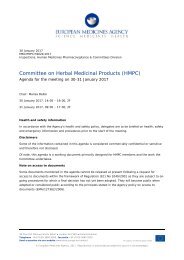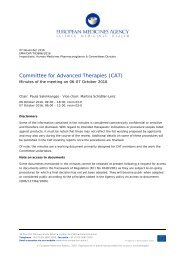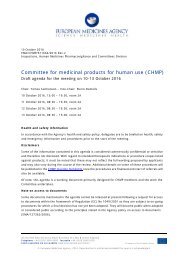Strategic Plan for Food Safety
9789241506281_eng
9789241506281_eng
- No tags were found...
You also want an ePaper? Increase the reach of your titles
YUMPU automatically turns print PDFs into web optimized ePapers that Google loves.
STRATEGIC DIRECTION 1economically to development and to improvingstandards of living in food-exportingcountries. Effective participationby all countries in the development ofinternational standards is essential toensure that they meet the needs of allMember States.15National and international standardsand policy decisions need to be basedon transparent, objective and state-ofthe-sciencerisk assessments. WHO is theglobal health authority <strong>for</strong> the provisionof independent, international food safetyrisk assessments. This work is undertakenin collaboration with FAO, throughthe organization of joint expert meetings.Continuous updates of general riskassessment principles and methods areimportant to take into account new scientificdevelopments.Access to reliable and current in<strong>for</strong>mation on the incidence of foodborne disease and the occurrenceof food contamination as well as a better understanding of the health burden of diseasesrelated to foodborne risks—expressed in Disability Adjusted Life Years (DALYs)—are critical toenable policy-makers as well as other food safety stakeholders to appropriately prioritize andallocate resources to foodborne disease prevention and control ef<strong>for</strong>ts; to monitor and evaluatethe effectiveness of measures taken; and to quantify the burden in monetary terms.Modern food safety systems, in order to be efficient, rely increasingly on the global availabilityand use of data and other in<strong>for</strong>mation on foodborne diseases and exposure to food contaminants—pathogens, natural toxins and other harmful chemicals— as well as data on the per<strong>for</strong>manceof controls throughout the food-chain. There<strong>for</strong>e, it is essential that effective links are establishedbetween food control agencies and the public health system. In this way, in<strong>for</strong>mationon food contamination through food monitoring can be linked with foodborne disease data andcan lead to early warning and appropriate risk-based food control policies. Moreover, the credibilityof a national food control system depends on the capabilities of those within the system toanalyse and act upon those data. Thus, being able to make the most of limited data by per<strong>for</strong>mingtrend analyses, modelling and <strong>for</strong>ecasting has become equally important in reducing theburden of foodborne disease and facilitating and monitoring an increasingly global food trade.








